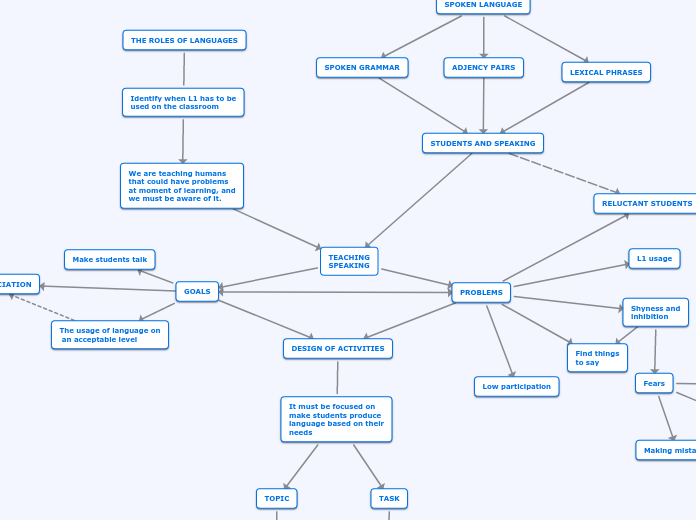TEACHING
SPEAKING
GOALS
Make students talk
The usage of language on
an acceptable level
PROBLEMS
Shyness and
inhibition
Fears
Making mistakes
Criticism
Social anxiety
Find things
to say
Low participation
L1 usage
RELUCTANT STUDENTS
Strategies to deal
whit them
Making them feel
relaxed
Matching level and task
Pair work
and group
work
Preparation
Adopting apropiate
teacher roles
Mandatory participation
DESIGN OF ACTIVITIES
It must be focused on
make students produce
language based on their
needs
TOPIC
Focused on make
students produce
based on their
experience and
knowledge
TASK
GOAL-ORIENTED;
Archivable by peers
interaction
GOOD PRONUNCIATION
SOUNDS
Phonetical aspects
RYTHM
The strees of
the speech
INTONATION
Accents
STRESS
Providing different
meanings based on
stressing sentences
THE ROLES OF LANGUAGES
Identify when L1 has to be
used on the classroom
We are teaching humans
that could have problems
at moment of learning, and
we must be aware of it.
SPOKEN LANGUAGE
SPOKEN GRAMMAR
LEXICAL PHRASES
ADJENCY PAIRS
STUDENTS AND SPEAKING
REPETITION
Activities which make
them repeat specific things
Acting from Scripts
Communication games
Descriptions
Questionnaires
Simulation and
Role-Play
Storytelling
Speaking Sequences
Making recordings
DEAL WITH
IT
SUPORTIVE FEEDBACK
IRF
It is not only
corrective, it highlight
what student have
done good
It is not a
direct correction,
so it force the
students to think
more carefully
what are they
saying
MISTAKE CORRECTIONS
Punctualice L1
interference
(Interlanguage)
Let them know
that making
mistakes is
part of language
adquisition
